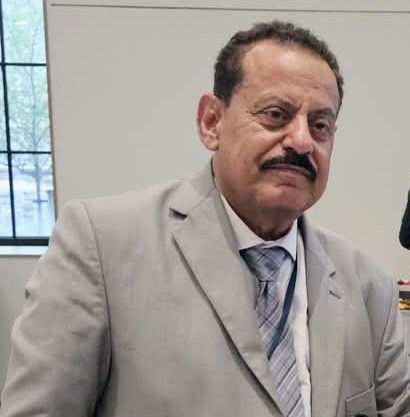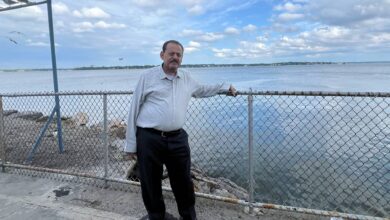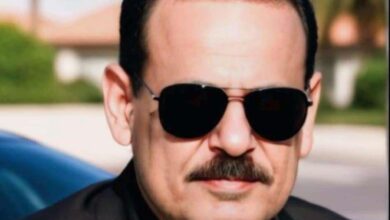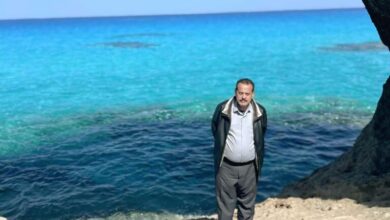A Horrid Face in the Mirror

Yemeni mp
Ahmed Saif Hashed
When I was about five or six years old, my mother would warn me, sometimes even scolding me, to prevent me from lingering too long in front of the mirror. Perhaps this restraint fueled my childhood curiosity and love for exploration, igniting a desire to revel in the unknown. It was as if my childhood yearned to uncover the details of itself in the mirror, which seemed to me a world unto itself; a realm of reflection that sparked wonder and questions! I longed to discover my own worlds through this mirror that was now within my reach?!
How do I appear to others? I wanted the mirror to reveal this truth clearly and in the finest details. Now, there was no one in my presence but the mirror, and the solitude that enveloped me from every direction. I must seize this opportunity and not waste a single moment of it. Curiosity is the passion for knowledge, and prohibition lends knowledge its value and reverence, provoking an insatiable urge for further discovery and understanding.
Today, I try to articulate a face from my childhood, those tender years between five and six, a time now passed and fading as I sway toward departure. Between that age and this one lie worlds, events, and details that feel so numerous they could not fit within a galaxy. Between childhood and the approaching twilight of old age, I have traversed a dense expanse, akin to the distance from nebula to solid existence, now heading toward the inevitability of aging, dissolution, and extinction.
In childhood, whenever I gazed into the mirror, I beheld wonder and miracle; I would stare at my face, wishing to memorize its details by heart, so that I could recall them at any moment, in any state or form I found myself in. I longed for a prolonged, deep gaze to uncover something I could see only in the mirror. I wished then that the mirror had been crafted by the Creator as a third eye somewhere within our bodies, allowing us to view our faces and entire selves with ease and grace whenever we desired.
Now, as I near middle age, I find myself carrying my own coffin upon my shoulders. An internal feeling intensifies within me: the older I grow, the more I see myself bearing a face that has wearied both it and me. It has grown weary of me, and I of it. The relentless passage of time crawls across its details, creasing, wrinkling, and carving furrows into it, telling tales of suffering, anguish, and rebellion—not only against the imposed reality but also against the very laws of life and the nature of the universe. Time has consumed us, day by day, overwhelming me after a long struggle, pushing me toward departure, dissolution, and oblivion. It is a weary journey from birth to the unknown, or what resembles nothingness.
* * *
In those early years, between five and six, when I found solitude, emptiness, and ample time to satiate my desires and curiosity, something strange happened that I still remember to this day. I was in the upper room of our old house, now distant and abandoned. The room was roofed over more than two-thirds, with the remainder left open to the sky. We called this room “the barada,” where the home’s entrance leaned in one of its corners, in the half that was exposed. This room felt inviting, granting a sense of comfort unlike any other place in the house.
I recall that the mirror was about the size of my face, or perhaps slightly larger, framed elegantly in a rectangular shape. It seemed to me that solitude with the mirror would be both delightful and joyous. There was no one with me in the room but it; in our smallness, we were vast. My worlds, unique to me, were abundant, and the mirror was a realm unto itself. Much has been said about it, from the days of myth and legend to the modern era and beyond, and there remains far more that we do not know than what we do.
I cannot precisely recall where my mother, aunt, and the others in the house were. It felt like a moment of distraction, almost akin to temptation. Most likely, they were preoccupied in other parts of the house or outside. What is certain is that I took advantage of my family’s distraction and secluded myself with the mirror. I wanted, among other things, to savor my solitude and enjoy the mirror in my possession for as long as possible.
I was watching my image in the mirror, imitating the movements of faces. I would frown, feign laughter, weep, and express anger. I would purse my lips and stretch them, thicken them and hide half of them. I furrowed my brow and relaxed it, astonished! I stuck out my tongue provocatively, twisting it in every direction. I knitted my brows and curled my lips to the right and then to the left. I would open my mouth wide and close it again, bulging my eyes and narrowing them, gazing in every direction. I jested with myself more than any jester could. I sought to discover the details of my face, not out of narcissism but a desire for knowledge. I winked, stared, gawked, focused intently. If anyone had seen me or caught on to what I was doing, I would have burst into laughter, filling the house I was hiding in with my mirth.
Suddenly, without warning, what I saw in the mirror shocked me. My face seemed to have been snatched away and replaced by another. The reflection was no longer the face I recognized. Instead, I saw a visage that filled the mirror, resembling that of “Nemah,” who lived in a modest home beneath “Mojar.” They said she was a bit mad, but her face was that of a hideous old crone, marked by deep, numerous wrinkles, like a complex topographical map with steep descents.
A face that instilled terror and unease within me, its details etched in my memory to this day. I cannot forget it as long as I live. It was a visage marked by deep, crowded wrinkles, more densely layered than the steep slopes and ravines of a mountain. A stern, grim, and frightening face that shocks you with immediate dread the moment you see it.
I nearly screamed and quickly dropped the mirror in terror. I fled from the room out into the open air nearby, seeking refuge beside the “Gharb” of the dripping water. The water served to protect us, shielding us from spirits, sorcery, and possession.
My heart nearly jumped in terror from my chest. A profound panic seized me, almost driving me to madness. In the aftermath of that encounter, my memory recalled my mother’s warnings against lingering too long before the mirror.
But where did my mother derive this advice? Perhaps she had heard of similar occurrences to what had just happened to me. I vaguely recalled her mentioning a girl who had experienced something akin to my own ordeal, though I had paid little heed. I was fortunate, for I had heard that the girl’s mind had been lost. Perhaps her advice stemmed from such tales or warnings.
As I grew older, I discovered that such warnings were common and well-known among many cultures for ages. It was, for me, a shocking experience; at the very least, I could say it was “a terrifying and horrific encounter.
There are numerous legends and myths surrounding mirrors. Some speak of a terrifying woman who lures her victims into the mirror, trapping them there for eternity. Others tell of a person encountering their doppelgänger, while some claim that mirrors are gateways to another realm, through which frightening supernatural beings emerge. Some believe that mirrors are haunted by ghosts and the spirits of the dead, while others assert that they can lead to the love and obsession of jinn for humans, or even to possession and illness.
My mother told me that what I saw in the mirror was a jinn, and I nearly lost my mind over what had happened. Surely, madness would follow if I lingered too long before it. After days of avoiding the mirror, driven by curiosity and the need to confirm whether I could see my reflection once more—or if my separation from the mirror would be permanent.
I returned to gaze upon my image in the presence of my mother. I peered cautiously and stealthily into the mirror, hoping to catch a glimpse of my reflection. To my relief, I found it truly was my face and not that of the old crone. I felt reassured that I was well, and that the world and I were still at peace and in harmony.
* * *
Some believe that mirrors can answer certain questions, revealing, for instance, the whereabouts of someone we seek or the fate of those whose destinies remain unknown. I read a comment from someone who studied in the Soviet Union, describing a custom he encountered in a rural area of Russia. When someone goes missing and their fate is uncertain, one ascends to the rooftop at night, placing a mirror before the person conducting the revelation, flanked by two candles or a dim light. Once the revelation is complete, the person nearby must tap the shoulder of the seer to bring them back to consciousness, lest they descend into madness.
In another comment, I read about a Yemeni man who, at the age of twelve, witnessed his sister searching for her husband, a soldier whose fate had been lost during the summer war of 1994. She clung to hope, however fragile it might be. She knocked on the door of Al Shaikh or sorcerer, who brought forth a mirror and handed it to her younger brother. Years later, he recounted;
“Al Sheikh instructed me to focus on the pupil of my eye and asked me to see where my sister’s husband was. At first, I saw nothing. The elder kept asking what I could see, and I only noticed the reflection of what was behind me—myself and the light. But then I concentrated more and saw him in a specific place. I described the location to them, and when my sister’s husband, who had been a prisoner, returned, he confirmed he had been in the very spot I described. To be honest, I also saw people dressed in ancient Roman attire (soldiers wearing the helmets that Romans used to wear).
There are other tales I have heard on various occasions that align with these claims or are closely related. For example, when one wishes to search for a thief who has robbed them, they bring in a young child, aged between six and twelve, and have them gaze intently into a small bowl of water, which seemingly acts as a mirror.
Yet, all of this remains mere hearsay without any scientific foundation, as long as it has not been investigated or validated by science. Some attempt to connect it to discussions of unexplored consciousness or hypnosis, or similar claims that require substantiation, research, and evidence.
* * *
In an effort to interpret or understand the shocking moment or terrifying experience I underwent, I read that Giovanni Caputo, an Italian researcher in optics from the University of Urbino, conducted a study in 2010. He conducted an experiment involving fifty volunteers, who were asked to focus their gaze on a mirror placed in a dimly lit room for ten minutes. He documented the results in a paper titled “A Strange Face in the Mirror”.
The results revealed that a significant number of volunteers witnessed changes and distortions in their faces in the mirror. Following them, some reported seeing the faces of strangers or deceased relatives, while a few even saw animals like cats and pigs.
The most important conclusion drawn from the research was that what occurred was due to the brain’s failure to process the data transmitted by the eyes. A functional shortcoming in the brain, caused by its focus on a specific part of the image while neglecting the rest, led to the edges of the face fading or becoming distorted. This mental anomaly sent incorrect signals to vision.
* * *
This field of study may still be in its infancy and requires extensive scientific research. The possibilities and hypotheses are numerous, ranging from illusions and visual hallucinations to cognitive misdirection, brain deception, or errors in how the brain interprets sensory input, suggestion, imaginative reserves, psychological and emotional factors, external influences, and neurological imbalances.
The mysteries held within consciousness and what is termed the unconscious are still abundant, many of which remain unknown or unconfirmed by science. Furthermore, much of the potential of consciousness remains elusive to scientific understanding. Science has yet to uncover many secrets of the brain and explore its intricate corridors, depths, and capabilities.
The inability to explain the mysterious should not lead us to fall prey to superstition. The efforts of science in exploration and discovery are far closer to the truth than resorting to ignorance and myth.
Clinging to the unseen represents a cognitive failure above all else. What science cannot grasp today, it will surely comprehend tomorrow, after a span of time. The future is long and does not end within a millennium or two. Science dispels superstition and triumphs over it continually. The future holds the winning bet, and science emerges victorious each day. Even if science encounters a setback, it persists and strives until it prevails.
* * *






